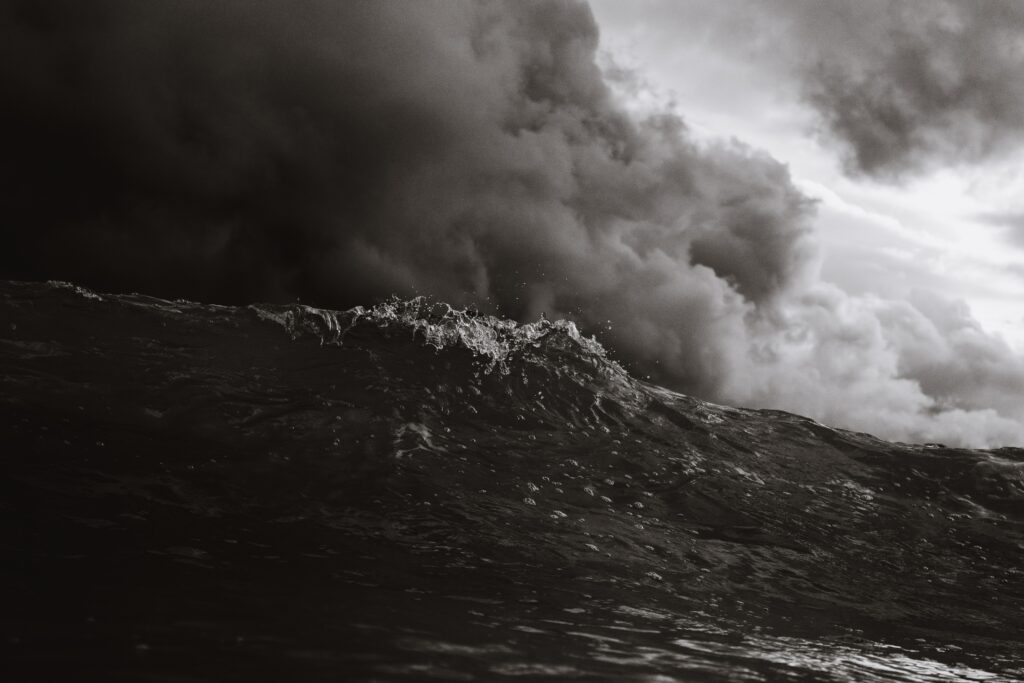
Sometimes I picture him on the water. I’m in the boat with the others, hands on the gunwale, peering over the side. The sea and sky are dark and churning together, obscuring any horizon. In the distance, small, faint in the dark, I see him standing ; still, calm, unshaken and approaching.
Jesus walking on the waves has always been a paradigmatic image for me, one I’ve returned to over and over. My inner life always felt like a turbulent sea, and as I’ve gotten older I’ve seen that same chaos more and more in the world and even, increasingly in these days, in the church. It’s one thing, though, to know the meaning of this event in Jesus’ life, and another to live it out. But living it out’s what we desperately need.
Studying this passage has helped me see that living it out’s not about finding peace from the chaos and disorder of life in the here and now; it’s a case of finding peace in it. Jesus didn’t walk out to his disciples to calm the storm. He could’ve done that from the shore, and hours earlier. In Mark’s account Jesus approaches the boat on the waves but makes to pass them by (Mark 6:48). Matthew’s account has Jesus telling Peter to walk out on the waves with him, while the sea’s still raging. The question is, in the midst of the storm, will they have faith, and therefore peace, in him? And what should’ve brought the disciples peace was seeing him with them in the raging sea. They could know that he had the sea in hand, and they would be ok. But they missed him.
And I can’t see him either, when I look with eyes of fear. When fear, or anger, are in control they become the lens through which I see the world – a lens that obscures him. A ghost – part of the chaos and death of the world around us – or, as with Peter when he walked on the water, turning our eyes away from him altogether to centre our gaze on the waves. How can we bring those feelings to him in the midst of the raging sea, and allow him to be the controlling lens through which we view them?
One thing I try do is picture him on the waves. When I feel the wind and waves of this chaotic world churning around me, I take a moment (it’s usually just a moment at a time these days) to pause, close my eyes, and picture those waves churning on the sea. The darkness. The boat I’m on, tossed about but stuck, unable to get through. And there in the distance, faint in the darkness, that figure standing. Unswayed by the waves. Calm. Approaching.
I’ve realised that what I’m doing in those moments is a way of meditating on the word. It’s taken me a while to come round to meditation, given the general evangelical suspicion of it. But whatever unhelpful practices dubbed meditation might be out there – and they are – meditating on God’s word is biblical and builds on the evangelical bedrock of studying God’s word. I study scripture by working through it to understand the meaning and application. I have studied the walking on the waves many times. But when I meditate on it, I take what I’ve learned through study and I sit with it. I immerse myself in it, let it work on me, let it sink deeply into my heart. Really listen, or in this case, look. And this method of visualising an incident is, I realise, the most natural way for me.
So there he is. Approaching on the waves. The one who spoke the waves into existence, under whose feet they stay. The one who would defeat all the chaos, disorder and evil of the world at the cross and rise. The one who comes to me in the darkness, who will lead me to the shore. He calls out to me in the darkness. I can hear what he says.
I am. Don’t be afraid.
Photo by Matt Hardy on Unsplash
